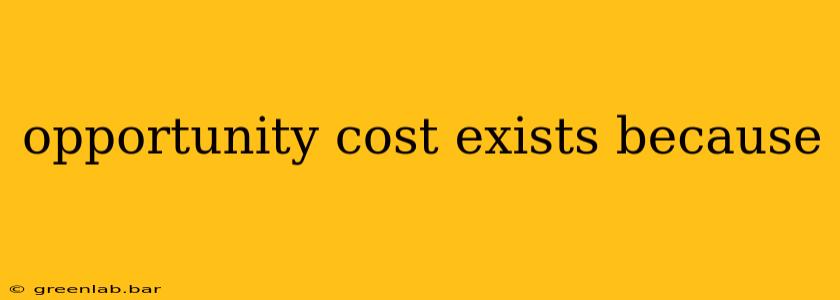Opportunity cost exists because of scarcity. This fundamental economic principle dictates that resources – whether time, money, materials, or labor – are limited in supply, while human wants and needs are unlimited. Because we can't have everything we want, we constantly face choices. Every decision we make involves trading off one opportunity for another. This trade-off represents the opportunity cost.
Understanding Scarcity and its Impact
Scarcity forces us to make choices. Let's break this down:
- Limited Resources: We live in a world with finite resources. There's only so much land, labor, capital, and raw materials available. This constraint applies to individuals, businesses, and even entire nations.
- Unlimited Wants: Human desires are virtually limitless. We always want more – more goods, more services, more experiences. This inherent desire for more creates a constant tension against the limited resources available.
- The Choice Conundrum: The conflict between limited resources and unlimited wants forces us to choose. Every time we allocate a resource to one use, we automatically forgo the opportunity to use that same resource for something else.
Examples Illustrating Opportunity Cost
The concept of opportunity cost becomes clear through real-world examples:
- Investing Time: Imagine you're deciding between spending an evening studying for an exam and going out with friends. The opportunity cost of studying is the fun evening with friends; conversely, the opportunity cost of going out is the potential improvement in your exam grade from studying.
- Financial Decisions: Suppose you're choosing between investing in stocks and buying a new car. The opportunity cost of investing in stocks is the immediate gratification of owning a new vehicle. Conversely, the opportunity cost of buying the car is the potential return on your investment in the stock market.
- Business Choices: A company deciding whether to launch a new product or expand its existing facilities faces an opportunity cost. Launching a new product means potentially forgoing the benefits of expanding existing facilities, and vice versa.
The Invisible Hand of Opportunity Cost
Opportunity cost isn't always easily quantifiable, but it's always present. It subtly influences our decisions, guiding our choices even when we're not consciously aware of it. Understanding this concept is crucial for:
- Rational Decision-Making: By explicitly considering opportunity costs, individuals and businesses can make more informed and efficient choices, maximizing the value they obtain from their limited resources.
- Resource Allocation: Businesses use opportunity cost analysis to determine the most profitable use of their resources, leading to greater efficiency and competitiveness.
- Economic Policy: Governments consider opportunity costs when making policy decisions, such as allocating funding to different sectors of the economy or implementing various regulations.
Beyond Monetary Value: The Broader Perspective
It's important to note that opportunity cost isn't solely about monetary value. It encompasses the value of the next-best alternative, regardless of whether it's expressed in dollars and cents. The value can be subjective and based on individual preferences.
In conclusion, the existence of opportunity cost is a direct consequence of scarcity. Understanding this fundamental economic principle is essential for making sound decisions in all aspects of life, from personal finance to business strategy and governmental policy. By acknowledging the trade-offs inherent in every choice, we can make more rational and effective decisions that align with our goals and priorities.

